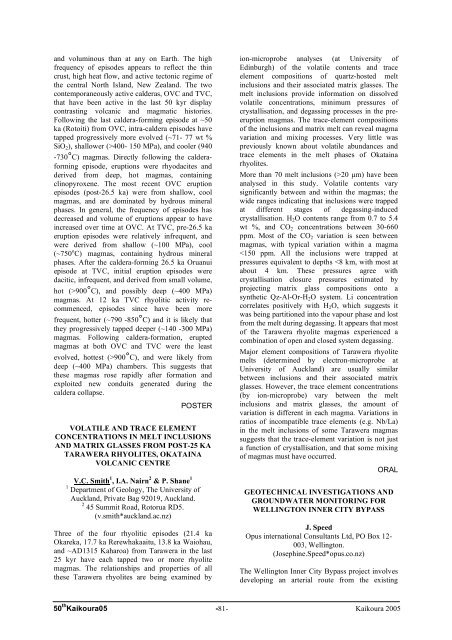50thKaikoura05 -1- Kaikoura 2005 CHARACTERISATION OF NEW ...
50thKaikoura05 -1- Kaikoura 2005 CHARACTERISATION OF NEW ...
50thKaikoura05 -1- Kaikoura 2005 CHARACTERISATION OF NEW ...
Create successful ePaper yourself
Turn your PDF publications into a flip-book with our unique Google optimized e-Paper software.
and voluminous than at any on Earth. The high<br />
frequency of episodes appears to reflect the thin<br />
crust, high heat flow, and active tectonic regime of<br />
the central North Island, New Zealand. The two<br />
contemporaneously active calderas, OVC and TVC,<br />
that have been active in the last 50 kyr display<br />
contrasting volcanic and magmatic histories.<br />
Following the last caldera-forming episode at ~50<br />
ka (Rotoiti) from OVC, intra-caldera episodes have<br />
tapped progressively more evolved (~71- 77 wt %<br />
SiO2), shallower (>400- 150 MPa), and cooler (940<br />
-730°C) magmas. Directly following the calderaforming<br />
episode, eruptions were rhyodacites and<br />
derived from deep, hot magmas, containing<br />
clinopyroxene. The most recent OVC eruption<br />
episodes (post-26.5 ka) were from shallow, cool<br />
magmas, and are dominated by hydrous mineral<br />
phases. In general, the frequency of episodes has<br />
decreased and volume of eruptions appear to have<br />
increased over time at OVC. At TVC, pre-26.5 ka<br />
eruption episodes were relatively infrequent, and<br />
were derived from shallow (~100 MPa), cool<br />
(~750 o C) magmas, containing hydrous mineral<br />
phases. After the caldera-forming 26.5 ka Oruanui<br />
episode at TVC, initial eruption episodes were<br />
dacitic, infrequent, and derived from small volume,<br />
hot (>900°C), and possibly deep (~400 MPa)<br />
magmas. At 12 ka TVC rhyolitic activity recommenced,<br />
episodes since have been more<br />
frequent, hotter (~790 -850°C) and it is likely that<br />
they progressively tapped deeper (~140 -300 MPa)<br />
magmas. Following caldera-formation, erupted<br />
magmas at both OVC and TVC were the least<br />
evolved, hottest (>900°C), and were likely from<br />
deep (~400 MPa) chambers. This suggests that<br />
these magmas rose rapidly after formation and<br />
exploited new conduits generated during the<br />
caldera collapse.<br />
POSTER<br />
VOLATILE AND TRACE ELEMENT<br />
CONCENTRATIONS IN MELT INCLUSIONS<br />
AND MATRIX GLASSES FROM POST-25 KA<br />
TARAWERA RHYOLITES, OKATAINA<br />
VOLCANIC CENTRE<br />
V.C. Smith 1 ,I.A.Nairn 2 & P. Shane 1<br />
1 Department of Geology, The University of<br />
Auckland, Private Bag 92019, Auckland.<br />
2 45 Summit Road, Rotorua RD5.<br />
(v.smith*auckland.ac.nz)<br />
Three of the four rhyolitic episodes (21.4 ka<br />
Okareka, 17.7 ka Rerewhakaaitu, 13.8 ka Waiohau,<br />
and ~AD1315 Kaharoa) from Tarawera in the last<br />
25 kyr have each tapped two or more rhyolite<br />
magmas. The relationships and properties of all<br />
these Tarawera rhyolites are being examined by<br />
ion-microprobe analyses (at University of<br />
Edinburgh) of the volatile contents and trace<br />
element compositions of quartz-hosted melt<br />
inclusions and their associated matrix glasses. The<br />
melt inclusions provide information on dissolved<br />
volatile concentrations, minimum pressures of<br />
crystallisation, and degassing processes in the preeruption<br />
magmas. The trace-element compositions<br />
of the inclusions and matrix melt can reveal magma<br />
variation and mixing processes. Very little was<br />
previously known about volatile abundances and<br />
trace elements in the melt phases of Okataina<br />
rhyolites.<br />
More than 70 melt inclusions (>20 µm) have been<br />
analysed in this study. Volatile contents vary<br />
significantly between and within the magmas; the<br />
wide ranges indicating that inclusions were trapped<br />
at different stages of degassing-induced<br />
crystallisation. H2O contents range from 0.7 to 5.4<br />
wt %, and CO2 concentrations between 30-660<br />
ppm. Most of the CO2 variation is seen between<br />
magmas, with typical variation within a magma<br />















